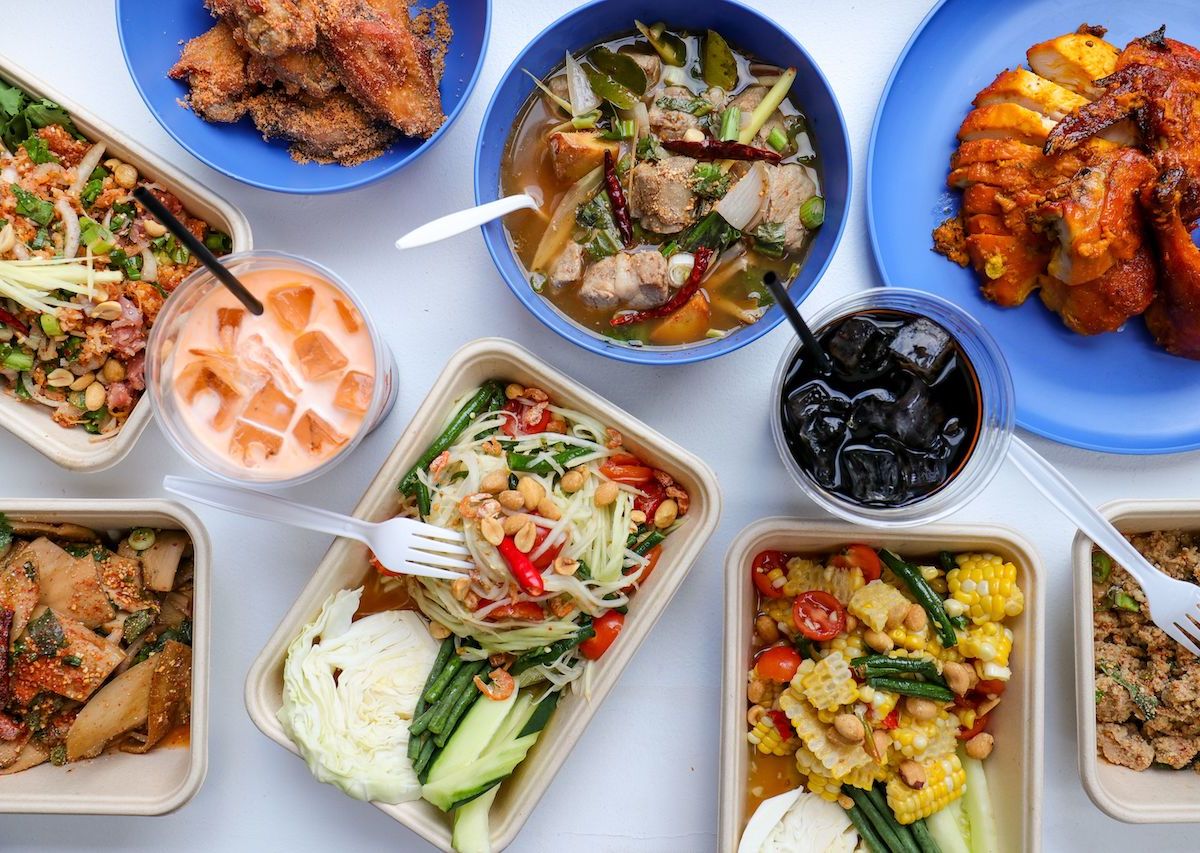In this article, you will learn about the authentic flavors of Isan cuisine. We will discuss the unexplored culinary delights of this region, known for its unique and delicious dishes. From spicy papaya salad to grilled meat with sticky rice, Isan cuisine offers a wide variety of flavors and textures that will surely tickle your taste buds. We will also explore some of the popular tourist attractions and cities in Thailand, as well as the stunning beaches that make this country a paradise for food and travel enthusiasts. So get ready to discover the rich and vibrant world of Isan cuisine!
Introduction to Isan Cuisine
Isan cuisine, also known as Northeastern Thai cuisine, is a vibrant and flavorful culinary tradition that is unique to the northeastern region of Thailand. This cuisine is characterized by its bold and spicy flavors, the use of fresh herbs and spices, and its emphasis on simple and humble ingredients. In this article, we will take a deep dive into the world of Isan cuisine, exploring its history and origins, key ingredients, popular dishes, regional variations, traditional cooking techniques, street food culture, fusion with international flavors, health benefits, traditional beverages, sustainability practices, and its significance in Thai culture. So get ready to embark on a culinary adventure and discover the authentic flavors of Isan cuisine.
The Unique Flavors of Isan Cuisine
One of the defining characteristics of Isan cuisine is its unique and distinctive flavors. Isan dishes are known for their bold and spicy profiles, often incorporating ingredients like chilies, garlic, shallots, and lime. The use of fresh herbs and spices such as lemongrass, cilantro, mint, and Thai basil further enhances the flavors of Isan dishes, giving them a refreshing and aromatic quality. These flavors are well-balanced, with a combination of spicy, sour, sweet, and salty tastes, creating a harmonious explosion of flavors on the palate. If you are a fan of bold and spicy foods, Isan cuisine will certainly tickle your taste buds.
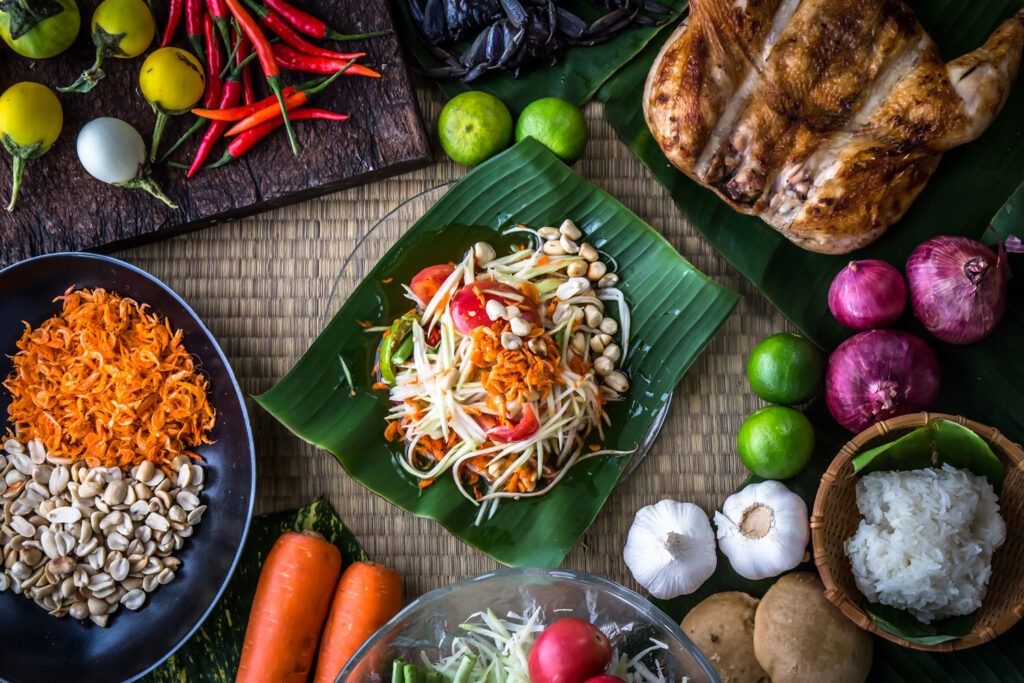
The History and Origins of Isan Cuisine
Isan cuisine has its roots in the Lao and Khmer cultures, as the northeastern region of Thailand shares borders with both Laos and Cambodia. The cuisine has been heavily influenced by the culinary traditions of these neighboring countries, resulting in a fusion of flavors and cooking techniques. The people of Isan have always relied on simple and humble ingredients due to the region’s predominantly agricultural economy. Rice, sticky rice in particular, is a staple in Isan cuisine, and dishes often feature grilled or smoked meats, fermented and preserved vegetables, and a variety of herbs and spices. Over the years, Isan cuisine has evolved and gained recognition not only within Thailand but also internationally, with its unique flavors captivating the taste buds of food enthusiasts around the world.
Key Ingredients in Isan Cuisine
The Role of Sticky Rice in Isan Cuisine
Sticky rice, also known as glutinous rice, is a vital component of Isan cuisine. It is not only a staple food but also plays a significant role in the culture and traditions of the region. Sticky rice is different from regular rice, as it has a sticky texture when cooked, making it perfect for rolling into small balls and using as a utensil to scoop up other dishes. In Isan cuisine, sticky rice is often served alongside other dishes, acting as a neutral base to complement the bold flavors of spicy and savory dishes. It is usually steamed in traditional bamboo baskets, which impart a unique earthy flavor to the rice. A meal in Isan is incomplete without a generous serving of sticky rice.
The Importance of Fresh Herbs and Spices
Fresh herbs and spices are the backbone of Isan cuisine, adding depth of flavor and aromatic notes to dishes. Lemongrass, cilantro, mint, Thai basil, and kaffir lime leaves are commonly used in Isan recipes, infusing dishes with their refreshing and citrusy flavors. These herbs have both culinary and medicinal properties, making Isan cuisine not only delicious but also beneficial for health. Thai chilies, garlic, and shallots provide the signature spiciness to Isan dishes, while lime juice and fish sauce add tanginess and depth. The combination of these fresh herbs and spices creates a symphony of flavors that is sure to tantalize and delight your taste buds.
The Versatility of Fish Sauce
Fish sauce, known as “nam pla” in Thai, is a staple ingredient in Isan cuisine. It is made from fermented fish, usually anchovies or mackerel, that are mixed with salt and left to ferment for several months. Fish sauce adds a savory and umami flavor to dishes, enhancing the overall taste and complexity. It is not only used as a seasoning but also as a dipping sauce or marinade for grilling meats. Fish sauce is a versatile ingredient, and its unique flavor profile is a key component of Isan cuisine. Just a small amount of fish sauce can elevate the flavors of a dish and bring it to a whole new level.
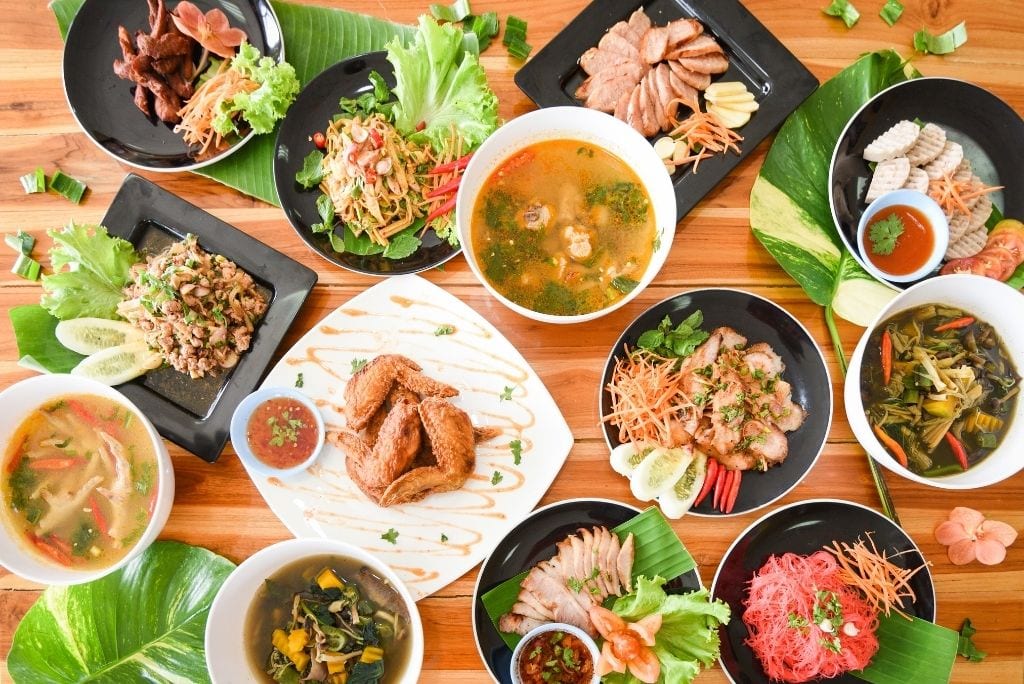
Popular Isan Dishes
Isan cuisine offers a wide variety of dishes, each showcasing the bold and vibrant flavors of the region. Let’s explore some of the most popular Isan dishes that you must try.
Som Tam: The Spicy Papaya Salad
Som Tam is a classic Isan dish that has gained popularity not only in Thailand but also internationally. It is a spicy and refreshing salad made with shredded green papaya, tomatoes, green beans, garlic, Thai chilies, lime juice, fish sauce, and palm sugar. The ingredients are pounded together in a mortar and pestle, releasing their flavors and creating a harmonious blend of sweet, sour, spicy, and salty tastes. Som Tam is often enjoyed with sticky rice and grilled meats, creating a delicious and satisfying meal that showcases the unique flavors of Isan cuisine.
Laab: The Traditional Meat Salad
Laab, also spelled as Larb, is a traditional meat salad that originated in Isan and has become a favorite dish throughout Thailand. It is typically made with minced pork, beef, or chicken, cooked with a combination of fresh herbs, spices, and roasted rice powder. The meat is seasoned with lime juice, fish sauce, chili powder, and herbs like mint and cilantro. Laab is known for its robust flavors and aromatic qualities, with the combination of roasted rice powder and fresh herbs adding a unique texture and depth of flavor. It is often served with fresh vegetables and sticky rice, making it a wholesome and satisfying dish.
Gai Yang: Grilled Chicken Isan Style
Gai Yang, or grilled chicken Isan style, is a popular street food dish that showcases the skillful use of marinades and grilling techniques in Isan cuisine. The chicken is marinated in a mixture of garlic, coriander roots, white pepper, fish sauce, and palm sugar, allowing the flavors to penetrate the meat. It is then grilled over charcoal, resulting in a juicy and flavorful chicken with a slightly smoky and charred exterior. Gai Yang is often served with a dipping sauce made from fish sauce, lime juice, garlic, and chili, adding an extra layer of tanginess and spiciness to the dish. This grilled chicken is a favorite among locals and visitors alike, showcasing the simple yet delicious flavors of Isan cuisine.
Regional Variations of Isan Cuisine
Isan cuisine is not limited to the northeastern region of Thailand. It has also developed unique regional variations in other parts of the country, each influenced by local ingredients and culinary traditions.
Isan Cuisine in Northern Thailand
In the northern region of Thailand, which includes cities like Chiang Mai and Chiang Rai, Isan cuisine has merged with the local Lanna cuisine to create a fusion of flavors. The dishes in this region often incorporate a wider variety of vegetables, herbs, and spices, resulting in a more diverse and complex flavor profile. Northern Isan dishes may include local specialties like sai ua (Northern Thai sausage), kaeng hang le (Northern Thai curry), and kaeng khanun (jackfruit curry). These dishes retain the bold and spicy flavors of Isan cuisine while incorporating unique local ingredients.
Isan Cuisine in Northeastern Thailand
In the northeastern region of Thailand, Isan cuisine showcases its authentic and traditional flavors. This is where the roots of Isan cuisine can be traced back, and the dishes here have a pure and unadulterated taste. The emphasis is on simple and humble ingredients, with dishes like som tam, laab, and gai yang taking center stage. The local markets in cities like Ubon Ratchathani and Nakhon Ratchasima are vibrant and bustling, offering a wide variety of Isan delicacies that are served with warmth and hospitality. Exploring the northeastern region of Thailand is a must for anyone who wants to experience the true essence of Isan cuisine.
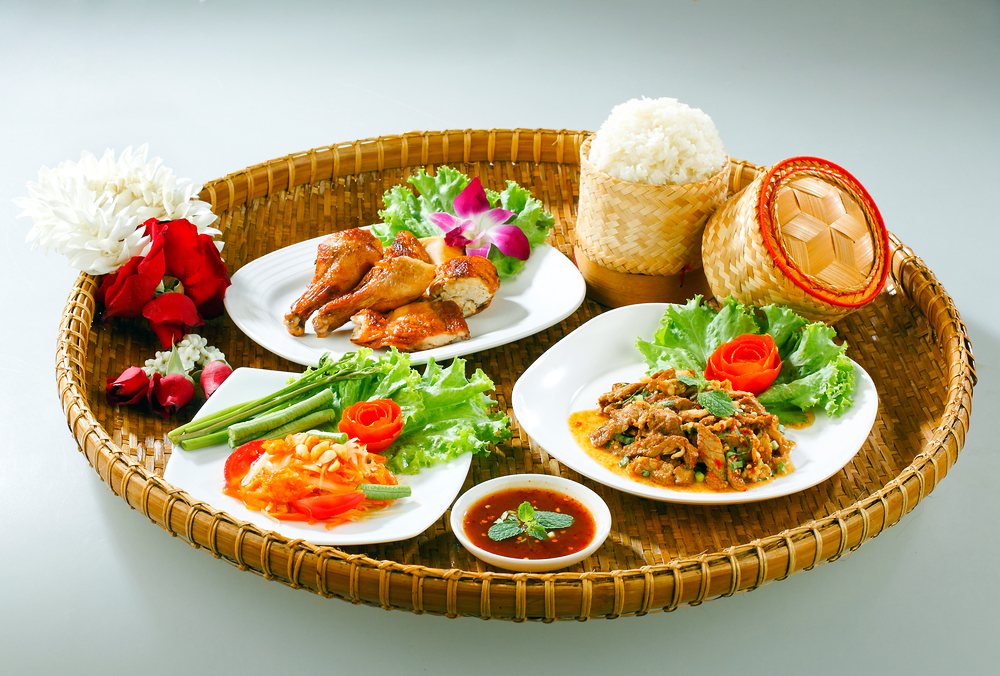
Traditional Cooking Techniques in Isan Cuisine
Isan cuisine features a range of traditional cooking techniques that have been passed down through generations. These techniques not only enhance the flavors of the dishes but also preserve the cultural heritage of Isan cuisine.
Grilling and Smoking
Grilling and smoking are popular cooking methods in Isan cuisine, particularly for meats. Grilled meats like chicken, pork, and beef are marinated in flavorful sauces or pastes before being cooked over charcoal or an open flame. The grilling process imparts a smoky and charred flavor to the meats, enhancing their taste and tenderness. Smoking is often used for preserving and flavoring foods like sausages and fish, adding an extra layer of complexity to the dishes. The combination of grilling and smoking techniques gives Isan cuisine a unique and distinct flavor profile.
Fermentation and Preservation
Fermentation and preservation techniques are also widely utilized in Isan cuisine to create unique and flavorful dishes. Ingredients like fish, meat, vegetables, and herbs are fermented to develop complex flavors and extend their shelf life. Fermented fish, known as “pla rah,” is a staple in Isan cuisine and is commonly used in various dishes. It has a pungent and intense flavor, adding a savory and umami taste to soups and sauces. Another popular fermented ingredient is “plara,” a type of fermented shrimp paste that is used as a flavor enhancer in many Isan dishes. The use of fermentation and preservation techniques not only adds depth and complexity to Isan cuisine but also reflects the resourcefulness and ingenuity of the local people.
Steaming and Boiling
Steaming and boiling are simple yet essential cooking techniques in Isan cuisine. Steaming is often used to cook sticky rice, which is a staple in Isan meals. The rice is placed in a bamboo basket and steamed over boiling water, resulting in a sticky and slightly chewy texture. Steamed sticky rice is enjoyed with various dishes, providing a neutral base to complement the bold flavors. Boiling is used for soups and broths, which are an integral part of Isan cuisine. These soups are usually packed with flavorful ingredients like herbs, vegetables, and meats, creating a nourishing and comforting meal.
Isan Street Food Culture
Isan street food culture is vibrant, bustling, and a true reflection of the region’s culinary heritage. Street food plays a significant role in the daily lives of Isan locals, as it provides quick, affordable, and delicious meals that are packed with flavor.
Exploring Vibrant Night Markets
Isan night markets are a feast for the senses, offering an array of street food stalls, bustling crowds, colorful lights, and lively music. These night markets are the perfect place to immerse yourself in Isan street food culture and sample a wide variety of dishes. The air is filled with the enticing aromas of grilling meats, sizzling stir-fries, and simmering soups. From som tam and laab to grilled meats and sticky rice, there is something to satisfy every craving. The vibrant atmosphere and the friendly nature of the street food vendors make the experience even more enjoyable.
Must-Try Street Food Stalls
When exploring Isan street food stalls, there are a few must-try dishes that should not be missed. Look out for vendors selling crispy fried chicken, which is seasoned with fragrant herbs and spices and deep-fried to perfection. Another popular street food item is moo ping, juicy and flavorful pork skewers that are marinated in a sweet and savory sauce before being grilled over charcoal. And of course, no visit to an Isan street food stall is complete without trying som tam, the spicy papaya salad that is synonymous with Isan cuisine. The combination of crunchy green papaya, tangy lime juice, spicy chilies, and umami fish sauce creates a taste sensation that will leave you wanting more.
Street Food Festivals and Events
Isan street food culture is celebrated through various festivals and events that showcase the diversity and vibrancy of the cuisine. One such event is the “Isan Food Festival,” held annually in the city of Nakhon Ratchasima. This festival attracts food enthusiasts from all over Thailand and features a wide variety of Isan dishes, live music performances, and cultural shows. It is a great opportunity to indulge in authentic Isan cuisine and immerse yourself in the lively atmosphere of the festival. Other cities in Isan also hold street food festivals and events throughout the year, providing ample opportunities to explore and savor the culinary delights of the region.
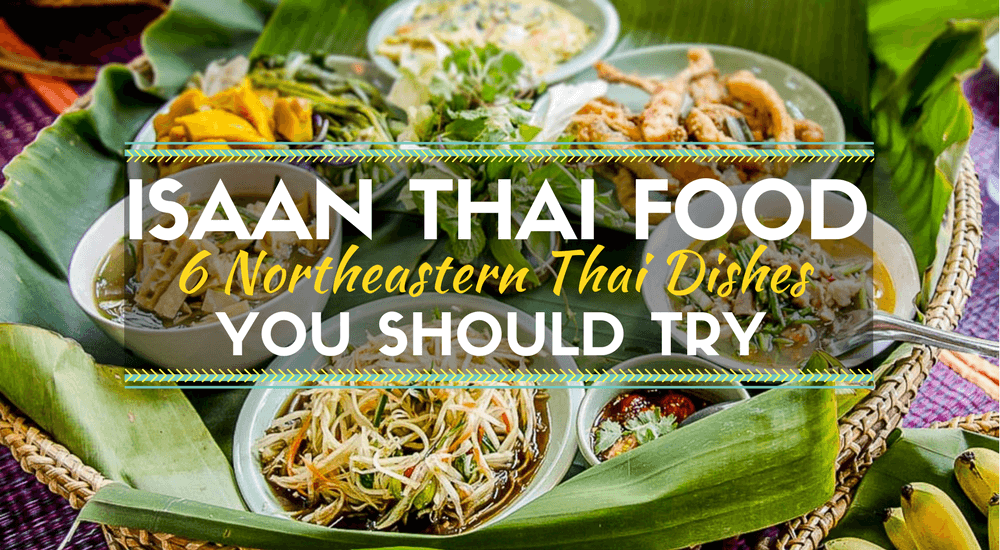
Fusion of Isan Cuisine with International Flavors
While Isan cuisine has a strong emphasis on its traditional flavors and ingredients, it has also embraced the fusion of international flavors to create exciting and innovative dishes.
Isan-Inspired Fusion Restaurants
In recent years, there has been a rise in Isan-inspired fusion restaurants, both in Thailand and abroad. These restaurants offer a modern twist on traditional Isan dishes, incorporating international flavors and ingredients. Chefs experiment with different textures, presentations, and cooking techniques to create unique and contemporary interpretations of Isan cuisine. You may find dishes like Isan-inspired tacos, Isan-style pasta, or Isan-infused burgers on the menu, giving you a fresh and exciting take on the authentic flavors of Isan cuisine.
Incorporating Isan Flavors in Western Dishes
Isan flavors have also made their way into Western dishes, allowing for a cross-cultural culinary experience. Chefs and home cooks around the world have started incorporating Isan ingredients and spices into their recipes to add a dash of vibrancy and complexity. Lime juice, fish sauce, Thai chilies, and fresh herbs like mint and cilantro can lend a unique twist to salads, stir-fries, soups, and even desserts. The fusion of Isan flavors with Western dishes creates a delightful blend of cultures and flavors, introducing a whole new world of culinary possibilities.
Isan Cuisine and Health Benefits
Isan cuisine not only tantalizes the taste buds but also offers numerous health benefits. The use of fresh herbs, spices, and vegetables in Isan dishes contributes to their nutritional value and supports overall well-being.
Nutritional Value of Isan Ingredients
Isan cuisine incorporates a wide variety of fresh herbs and vegetables, providing essential vitamins, minerals, and antioxidants. Herbs like lemongrass, cilantro, and Thai basil are rich in antioxidants and have anti-inflammatory properties. They also add flavor and aroma to the dishes. Vegetables like green papaya, tomatoes, and green beans provide fiber, vitamins, and minerals that promote digestive health and boost the immune system. Meats and seafood, when consumed in moderation, are excellent sources of protein and essential nutrients.
Isan Cuisine’s Balance of Flavors
Isan cuisine is known for its balance of flavors, which not only creates a delightful dining experience but also promotes overall health. The combination of spicy, sour, sweet, and salty tastes stimulates the taste buds and encourages mindful eating. Spicy foods, when consumed in moderation, can boost metabolism, aid digestion, and reduce inflammation. Sour flavors from lime juice and tamarind provide a good source of Vitamin C, while sweet flavors from palm sugar or fruits add a touch of natural sweetness. Isan cuisine’s emphasis on fresh and natural ingredients helps maintain a balanced and healthy diet.
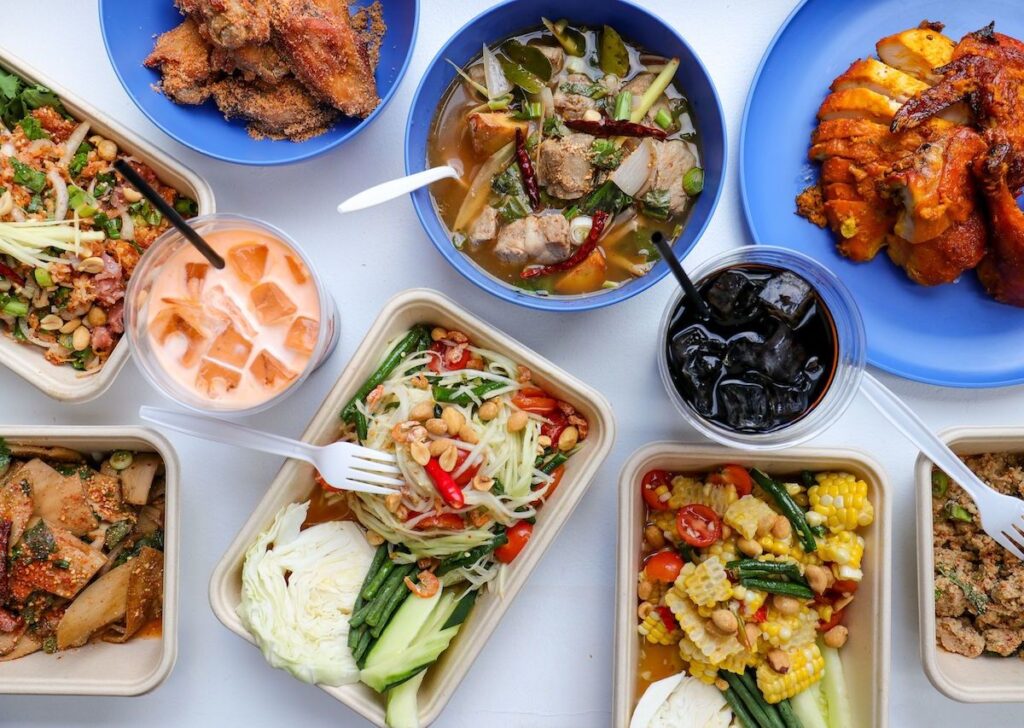
Traditional Isan Beverages
To complement the bold flavors of Isan cuisine, there are traditional beverages that provide refreshment and balance to the meal.
The Refreshing Lemongrass Drink
Lemongrass, with its citrusy and refreshing flavor, is a popular ingredient in Isan cuisine. It is also used to make a delightful beverage that is perfect for quenching your thirst on a hot day. Lemongrass stalks are boiled with water and sometimes sweetened with sugar or honey to create a fragrant and invigorating drink. The lemongrass drink is not only delicious but also known for its calming and digestion-enhancing properties. Sip on this refreshing beverage to cleanse your palate and cool off after enjoying a spicy Isan feast.
The Aromatic Thai Herbal Tea
Thai herbal tea is another popular beverage in Isan cuisine. Made from a blend of herbs such as butterfly pea flower, pandan leaves, and lemongrass, this tea has a unique taste and vibrant color. It is often sweetened with sugar or condensed milk, creating a smooth and aromatic drink. Thai herbal tea is also believed to have health benefits, including antioxidant properties and aiding digestion. Enjoy a cup of Thai herbal tea to experience the soothing and aromatic qualities that perfectly complement the bold and spicy flavors of Isan cuisine.
Isan Cuisine and Sustainability
Isan cuisine has a strong connection to sustainability, with a focus on supporting local farmers and promoting food waste reduction.
Supporting Local Farmers
Isan cuisine relies heavily on locally sourced ingredients, promoting the use of fresh and seasonal produce. By supporting local farmers, Isan cuisine contributes to the sustainability of the region’s agricultural economy. Local farmers are able to earn a livelihood by supplying fresh herbs, vegetables, and meats to the markets and restaurants. This not only helps in preserving traditional farming practices but also ensures that the ingredients used in Isan cuisine are of the highest quality and freshness.
Promoting Food Waste Reduction
Isan cuisine places great importance on utilizing every part of the ingredients and minimizing food waste. Techniques such as fermentation and preservation are used to extend the shelf life of foods, reducing the amount of discarded produce. By incorporating food waste reduction practices, Isan cuisine showcases its commitment to sustainability and environmental stewardship. Embracing the principles of reduce, reuse, and recycle, Isan cuisine contributes to a more sustainable and eco-friendly food system.
Isan Cuisine in Thai Culture
Isan cuisine holds a special place in Thai culture, playing a significant role in festivals, celebrations, and cultural identity.
Isan Cuisine in Festivals and Celebrations
Isan cuisine takes center stage in numerous festivals and celebrations throughout Thailand. Traditional dishes are prepared and shared among families and communities, creating a sense of togetherness and celebration. During the Songkran festival, the Thai New Year celebration, people come together to enjoy a wide variety of Isan delicacies and pay homage to their cultural roots. Festivals like the Bun Bung Fai Rocket Festival in Isan also feature elaborate feasts showcasing the best of Isan cuisine. Food is not only a means of sustenance but also a way to express love, gratitude, and cultural identity in Thai society.
Isan Cuisine as a Symbol of Cultural Identity
Isan cuisine serves as a symbol of cultural identity for the people of the northeastern region of Thailand. It reflects the ingenuity, resourcefulness, and resilience of the Isan people, who have created a unique culinary tradition from simple and humble ingredients. Isan cuisine brings people together, fostering a sense of community and pride in their cultural heritage. It is a testament to the richness and diversity of Thai culture and a reflection of the vibrant and expressive nature of the Isan people.
Challenges and Opportunities for Isan Cuisine
As Isan cuisine gains popularity internationally, there are both challenges and opportunities that arise in preserving its authenticity and exploring its culinary tourism potential.
Preserving Authenticity in a Globalized World
With the increasing globalization of food, there is a risk of diluting the authentic flavors and traditions of Isan cuisine. As Isan-inspired restaurants and fusion dishes gain popularity, it becomes crucial to preserve the core essence and integrity of Isan cuisine. This can be done by supporting local chefs and artisans who are dedicated to showcasing the true flavors of Isan, adhering to traditional cooking techniques and using locally sourced ingredients. By staying true to its roots, Isan cuisine can continue to captivate food enthusiasts while maintaining its authenticity.
Exploring Culinary Tourism Potential
Isan cuisine has the potential to become a major attraction for culinary tourists. Its unique flavors, traditional cooking techniques, and vibrant street food culture offer a distinct and memorable experience. By promoting Isan cuisine as a culinary tourism destination, local communities can benefit from increased tourism revenue and recognition. Culinary tours, cooking classes, and food festivals can provide opportunities for visitors to immerse themselves in the rich cultural heritage of Isan cuisine. This not only supports the local economy but also contributes to the preservation and promotion of Isan culinary traditions.
Isan Cuisine Trends and Innovations
While preserving authenticity is important, there is also room for innovation and creativity in Isan cuisine. Chefs and home cooks have been experimenting with modern techniques and creative presentations of traditional Isan dishes.
Modern Techniques in Isan Cuisine
As culinary techniques and technologies evolve, there is an opportunity to incorporate modern cooking techniques into Isan cuisine while still honoring its traditional flavors. Sous vide cooking, molecular gastronomy, and innovative kitchen equipment can be utilized to enhance the flavors and textures of Isan dishes. These modern techniques allow for precise control over the cooking process, resulting in dishes that are both visually appealing and bursting with flavor. The fusion of traditional Isan flavors with modern cooking methods can create a new wave of culinary delights that appeal to both traditionalists and adventure seekers.
Creative Presentations of Traditional Dishes
Another trend in Isan cuisine is the creative presentation of traditional dishes. Chefs and food artisans are finding innovative ways to plate and present Isan dishes, making them visually striking and enticing. Garnishes, edible flowers, and artistic plating techniques are used to elevate the aesthetic appeal of the dishes, creating a feast for the eyes as well as the palate. Creative presentations not only showcase the culinary skills and creativity of the chefs but also add an element of surprise and excitement to the dining experience.
Conclusion
Isan cuisine is a treasure trove of flavors, traditions, and culinary delights waiting to be discovered. From the bold and spicy profiles of dishes like som tam and laab to the vibrant street food culture, Isan cuisine offers a unique and immersive culinary experience. By exploring the history and origins, key ingredients, popular dishes, regional variations, traditional cooking techniques, street food culture, fusion with international flavors, health benefits, traditional beverages, sustainability practices, and its significance in Thai culture, we have delved into the authentic flavors of Isan cuisine. So the next time you find yourself in Thailand or seeking a taste of something new, don’t miss the opportunity to embark on a gastronomic adventure and discover the wonders of Isan cuisine.
